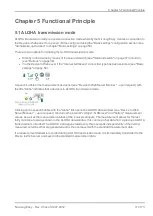
4.9 Installation of replacement and wear parts
Please be advised that replacement and accessory parts that have not been supplied by the manufacturer
have also not been inspected or approved by it. Installing or using such products and similar can con-
structively modify the specified properties of the device in a negative way. The manufacturer shall not be liable
for any damages that arise from the use of non-original parts and non-original accessory parts.
4.10 Storage of the product
Ensure that all of the relevant data has been transmitted to the Device to Web server before storing the Nivu-
Log Easy . If necessary initiate the ALOHA transmission mode using the magnetic contact (see "ALOHA
transmission mode" on page 17) and then check again that all relevant data has been transmitted. If you are
using an external charging voltage to charge the accu pack of the NivuLog Easy , disconnect this from the
device before removing the accu or battery pack. The remaining cables and antenna can then be removed.
Store the NivuLog Easy and accu or battery pack in the compartments provided in the original packaging.
The configuration and most recently determined data are retained. However, the system clock will not con-
tinue to work without an energy supply. This means that following recommissioning, the time must be syn-
chronised to ensure that measurement and log data timestamps are correct. This occurs automatically either
when the first connection is established with the Device to Web server or when the NivuLog Easy is con-
nected to the PC. For this purpose, the optional SIM/USB option and DeviceConfig configuration program
are required.
4.11 Obligation of the operator
WARNING:
In the EEA (European Economic Area), the national implementation of the framework direc-
tive (89/391/EEC) as well as the associated specific directives and from these in particular,
the directive (89/655/EEC) about the minimum safety and health requirements for use of
work equipment by workers at work, each in their respective version are to be complied
with.
The operator must obtain the local operating licence and the associated documents.
In addition, the operator must comply with the local legal requirements for
l
the safety of the personnel (accident prevention measures)
l
the safety of the equipment (protective equipment and maintenance)
l
the product disposal (waste disposal law)
l
the material disposal (waste disposal law)
l
the cleaning (cleaning agents and disposal)
l
and the environmental protection amendments.
Before commissioning, the operator must ensure that the installation and commissioning – provided these
were performed by the operator himself – are in compliance with the local regulations.
16 of 73
NivuLog Easy - Rev. 05 as of 02.07.2012
















































